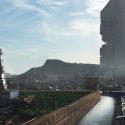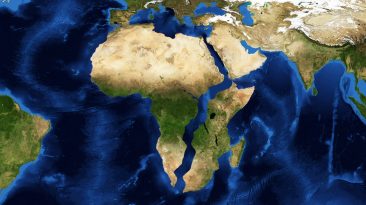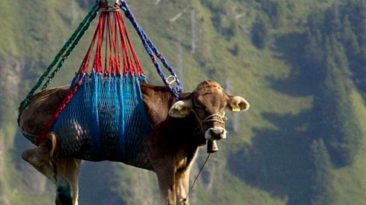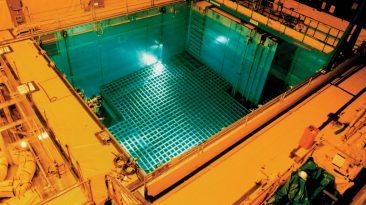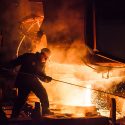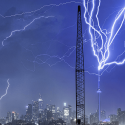Tectonic plates: can’t live with ’em, can’t live without ’em. Their movements cause some of the world’s deadliest disasters, but, as you’re about to see, the alternative is much, much worse.
Tectonic plates shift on top of a weak, fluid layer of rock called the asthenosphere. The asthenosphere is part of the Earth’s upper mantle, and while it’s a layer of solid rock, it gets so much heat and pressure from below that it flows like a liquid.
When molten hot rock pushes up from Earth’s core, it moves in opposite directions along the asthenosphere until it cools, and sinks back down towards the core. This process is called convection, and it’s what causes huge chunks of land to slide, separate, or collide.
Plate tectonics explain how we got from here (Pangaea), to here (Map of the world). And maybe you like the way the world looks now. Maybe you don’t like the fact that the plates are always shifting, that the Atlantic Ocean is expanding, that the Pacific is shrinking, and that in about 250 million years, we might be one continent again.
Well, if you insist, we’ll stop the plates for a moment. But.. it’s your funeral. Would you rather be warmer? Or colder? We can start there first.
For tectonic plates to stop moving, the Earth’s mantle will have to be too cold for convection to occur. If that were to happen, then it means the Earth’s outer core has likely solidified.
[dx_custom_adunit desktop_id=”RTK_CDE4″ mobile_id=”RTK_SUFd”]Normally a liquid layer, the outer core, transfers heat between the inner core and the mantle. But if that heat-transfer process breaks down, Earth either becomes a planet of ice, or a fireball.
On one hand, if heat can’t reach the mantle or Earth’s crust, then the whole planet might freeze. But then again, plate movement helps our planet regulate its internal temperature, since the convection process cools down hot molten rock from the Earth’s core. Unable to cool down, could the inner core cause our planet to combust?
Whether its a hot planet or a cold one, Earth’s topography would become a lot less interesting. Remember when Mount Everest was a natural wonder? It’s not one that will stand the test of time.
Convergent plates come together to form impressive mountain chains and terrifying volcanoes. But without plate tectonics, Earth will simply stop making new ones. The mountains we have now would erode over a few million years, turning into low, rolling hills. Our planet would eventually flatten out, with more land ending up underwater.
On the bright side, there’d be fewer natural disasters. Without subduction zones, where two convergent plates meet, earthquakes would be rare, and even then, they wouldn’t be very powerful. Volcanoes, for the most part, would be out of commission, since tectonic activity is generally what causes their eruption.
But if volcanoes are out, then so is Earth’s magnetic field. Our magnetic field is powered by convection currents within Earth’s iron outer core. But if this process fails, we lose our magnetic field. And without out our magnetic field, the earth has no more protection from deadly solar wind. The Sun would consume our atmosphere, sucking up the air we breathe, and boiling away the oceans. At that point, life on Earth becomes impossible.
So was stopping tectonic plates a little too much to ask? Yeah. It might be unsettling to know that you’re always on shaky ground, but keep in mind, tectonic plates move only as fast as your fingernails grow. But if that’s still something that worries you, just remember that, right now you’re moving at 1600 km/h (1000 mph)! So don’t worry! You’re perfectly safe… for now… So just sit back, relax, and go with flow.
Subscribe to What-If on Youtube or follow the show on Facebook Watch.
Sources
- “Caltech Question Of The Week: What Would Be The Effect If All Plate Tectonics Movement Stopped Forever? | Caltech”. 2018. The California Institute Of Technology. Accessed December 9 2018.
- “What Would Happen If The Tectonic Plates Stopped Drifting?”. DiBiase, Beth, 2013. Prezi.Com. Accessed December 9 2018.
- “Here’s What’ll Happen When Plate Tectonics Grinds To A Halt”. 2018. nationalgeographic.com. Accessed December 9 2018.
- “The 7 Natural Wonders Of The World”. Boland, Maria, 2010. MNN – Mother Nature Network. Accessed December 9 2018.
- “Plate Tectonics Theory Lesson”. 2018. Youtube. Accessed December 9 2018.
- “Mariana Trench”. 2018. en.wikipedia.org. Accessed December 9 2018.
- “Mount Everest”. 2018. en.wikipedia.org. Accessed December 9 2018.
- “Pangaea”. 2018. en.wikipedia.org. Accessed December 9 2018.
- “List Of Tectonic Plates”. 2018. en.wkipedia.org. Accessed December 9 2018.
- “Plate Tectonics Explained”. 2018. Youtube. Accessed December 9 2018.
- “What Is A Tectonic Plate? [This Dynamic Earth, USGS]”. 2018. pubs.usgs.gov. Accessed December 9 2018.
- “Plate Tectonics Definition: What Are Tectonic Plates And What Causes Them To Move?”. 2018. Youtube. Accessed December 9 2018.
- “Magnetic Field, Mantle Convection And Tectonics”. 2018. Sciencedaily. Accessed December 9 2018.
- “What Would Happen If Plate Tectonics Ceased – Complex Life”. 2018. fossilhunters.xyz. Accessed December 9 2018.











